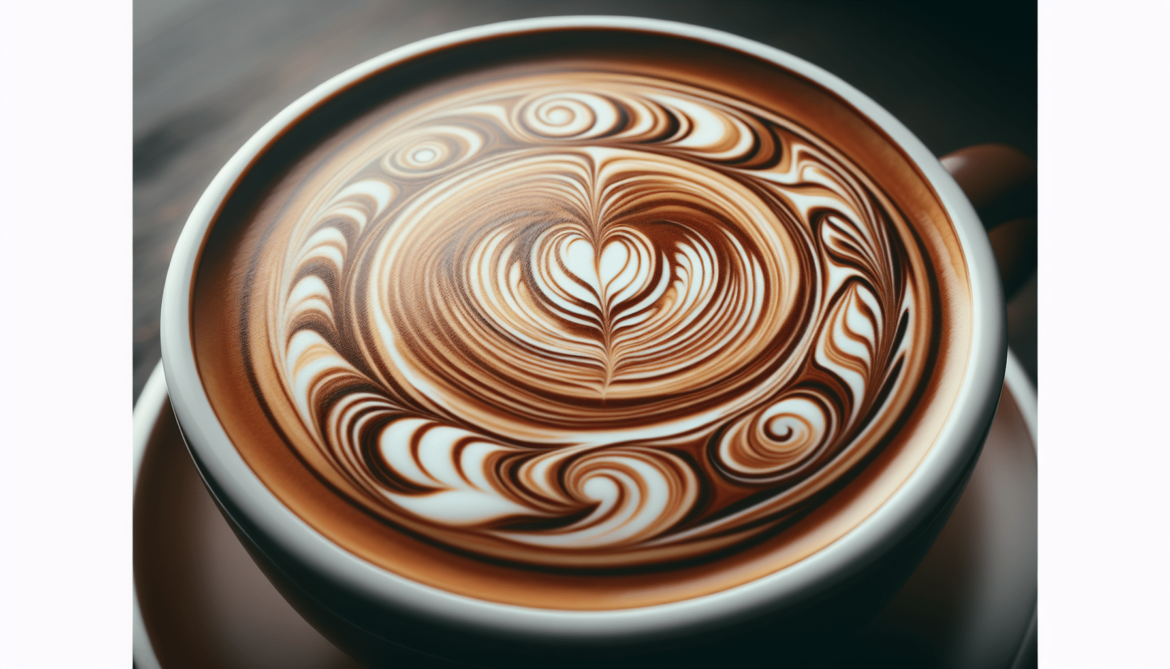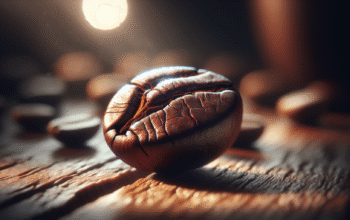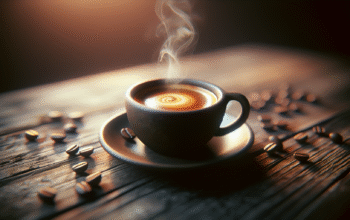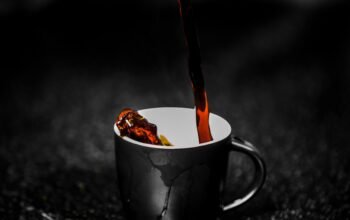Get ready to enter the world of Latte Art: Basics and Beyond! This captivating article will guide you through the fascinating journey of creating beautiful and intricate designs on your lattes. Whether you’re a coffee enthusiast looking to impress your friends or a professional barista seeking to take your latte game to the next level, this article will provide you with all the essential knowledge and techniques to master the art of latte decoration. From the fundamental swirls and hearts to more complex designs like rosettas and tulips, get ready to let your creativity flow and turn your morning cup of joe into a work of art!
History of Latte Art
Origins of latte art
Latte art can trace its origins back to the espresso bars of Italy in the 1980s. It was during this time that baristas started to experiment with creating visually appealing designs on the surface of their lattes. The initial designs were simple and limited to basic patterns, but they laid the foundation for the art form that latte art is today.
Evolution of latte art
As latte art gained popularity, baristas around the world started to push the boundaries and develop more complex and intricate designs. With the advent of social media, latte art began to capture the attention of coffee enthusiasts globally, leading to an explosion of creativity in the latte art community. Baristas began to experiment with different pouring techniques and tools, resulting in the development of a wide variety of designs.
Popularity of latte art
Today, latte art has become a significant part of coffee culture. It is not only appreciated for its visual appeal but also as a testament to a barista’s skill and craftsmanship. Cafes and coffee shops worldwide have embraced latte art, using it as a way to differentiate themselves and create a unique experience for their customers. In recent years, latte art has even become the focus of latte art competitions, where baristas from around the world showcase their talent and compete for recognition.
Tools and Techniques
Espresso machine
A high-quality espresso machine is the essential tool for creating latte art. It allows baristas to extract the perfect shot of espresso, which serves as the base for latte art. Investing in a reliable espresso machine is crucial to achieving consistent results.
Milk frothing pitcher
A milk frothing pitcher is used to steam and froth the milk. It is an essential tool for creating the microfoam needed for latte art. The pitcher should be of the right size and shape, allowing for proper control and manipulation of the milk during steaming.
Latte art pen or etching tool
A latte art pen or etching tool is used to create intricate designs on the surface of the latte. It can be used to draw shapes, lines, and patterns, adding a personal touch to the latte art. These tools come in various sizes and shapes, allowing baristas to experiment and create different effects.
Coffee stencils
Coffee stencils are another tool that can be used to create designs on the surface of a latte. They come in various shapes and designs, allowing for quick and easy decorating. Coffee stencils are especially useful for beginners who want to add a touch of creativity to their lattes without needing advanced pouring techniques.
Free pour technique
The free pour technique is one of the most common techniques used in latte art. It involves pouring steamed milk into the espresso while moving the pitcher in a back-and-forth motion. By mastering the free pour technique, baristas can create popular designs such as hearts, rosettas, and tulips.
Etching technique
The etching technique involves using a latte art pen or etching tool to create intricate designs on the surface of the latte. It is a more advanced technique that requires precision and control. Baristas can create detailed patterns, animals, or even portraits using the etching technique.
Choosing the Right Milk
Whole milk
Whole milk is the most commonly used milk for latte art due to its high fat content. The higher fat content makes it easier to achieve silky, microfoam milk, which is essential for creating latte art designs. Whole milk also provides a rich and creamy flavor that complements the espresso well.
2% milk
2% milk is an alternative option for those who prefer a lighter milk base for their lattes. It can still produce decent microfoam when properly steamed, although it may not have the same richness and creaminess as whole milk. 2% milk is a popular choice for those looking to reduce their calorie intake without sacrificing the quality of their latte art.
Non-dairy milk options
For those who are lactose intolerant or prefer non-dairy options, there are several alternatives available. Soy milk, almond milk, and oat milk are commonly used in latte art. Each non-dairy milk has its unique taste and texture, so baristas may need to experiment to find the one that works best for them. It’s important to note that non-dairy milk may require different steaming techniques to achieve the desired microfoam consistency.
Creating the Perfect Espresso
Selecting the right coffee beans
Choosing the right coffee beans is crucial for creating the perfect espresso base for latte art. The beans should be freshly roasted and of high quality to ensure a rich and flavorful espresso shot. Different coffee beans have distinct flavor profiles, so it’s essential to experiment and find the ones that complement your taste preferences.
Grinding the coffee beans
Grinding the coffee beans to the correct consistency is essential for achieving the perfect espresso shot. The grind size will depend on the brewing method and the espresso machine being used. A fine to medium-fine grind is typically recommended for espresso.
Tamping the coffee grounds
After the coffee grounds have been measured and placed in the espresso machine’s portafilter, they need to be tamped. Tamping involves evenly pressing down on the coffee grounds to create a tightly packed puck. Consistent pressure and a level tamp are crucial for ensuring proper extraction and a well-balanced espresso shot.
Brewing the espresso shot
Once the coffee grounds have been tamped, the portafilter can be attached to the espresso machine, and the brewing process can begin. The water should be heated to the appropriate temperature and allowed to pass through the coffee grounds at a steady rate. The result should be a rich and full-bodied espresso shot that serves as the foundation for the latte art design.
Steaming and Frothing Milk
Steaming vs frothing
Steaming and frothing are two essential steps in preparing the milk for latte art. Steaming involves heating the milk while creating microfoam, while frothing involves incorporating air into the milk to create a thicker and creamier texture. Both techniques can be used to achieve different effects and textures, depending on the desired latte art design.
Techniques for achieving silky, microfoam milk
To achieve silky, microfoam milk for latte art, baristas need to master the art of steaming. The milk should be heated to a specific temperature and textured to create tiny bubbles throughout the milk, resulting in a velvety smooth texture. Proper steam wand position, control of steam pressure, and milk stretching techniques are crucial for achieving the desired microfoam consistency.
Common mistakes to avoid
When steaming and frothing milk for latte art, several common mistakes can hinder the process. Overheating the milk, not properly purging the steam wand, and improper milk stretching can result in milk that is too hot, too bubbly, or lacking the necessary microfoam. It’s important to avoid these mistakes to achieve the desired texture and consistency for latte art.
Basic Latte Art Designs
Heart
The heart is one of the most iconic and classic latte art designs. It is created by pouring steamed milk in a circular motion, followed by a quick pour through the center to create the distinctive heart shape. The heart design is a great starting point for beginners and serves as the foundation for more complex designs.
Rosetta
The rosetta is a more intricate design that requires mastering the free pour technique. It involves pouring the milk in a pattern of alternating lines and dots, resulting in a leaf-like design. The rosetta design showcases a barista’s skill in creating symmetry and precision in their latte art.
Tulip
The tulip design is created by layering hearts on top of each other and then adding a stem with the milk stream. This design requires good control of the pouring technique and can be further enhanced with etching or pen work to add more detail and depth.
Swan
The swan design is considered more advanced due to its detailed and elegant appearance. It involves pouring the milk in a pattern similar to the rosetta, but with an additional pour to create the swan’s neck and head. Achieving the swan design requires a steady hand and an understanding of the pouring technique.
Leaf
The leaf design is a versatile and commonly used latte art design. It is created by pouring the milk in a circular motion, followed by a quick pour through the center and dragging a stirring tool through the milk to create the leaf shape. The leaf design is a great option for beginners to practice their free pour technique and create visually appealing latte art.
Advanced Latte Art Designs
Multiple layers design
Multiple layers design is a more complex and visually striking latte art design. It involves pouring different layers of steamed milk to create a three-dimensional effect. By carefully controlling the pouring technique and layering the milk, baristas can create stunning designs with depth and texture.
3D latte art
3D latte art takes latte art to a whole new level by creating three-dimensional designs that seem to come alive on the surface of the latte. Baristas use their steamed milk as a sculpting medium to create intricate designs, such as animals, flowers, or even famous landmarks. Achieving 3D latte art requires advanced pouring and sculpting techniques.
Animal and cartoon designs
Latte art can also be a canvas for creating fun and playful designs. Baristas often showcase their creativity by pouring milk into shapes that resemble animals or cartoon characters. From teddy bears to cats to Disney characters, the possibilities are endless. These designs require good control of pouring techniques and the ability to visualize and create recognizable shapes on a small canvas.
Intricate patterns
For those who appreciate intricate and detailed designs, latte art offers endless possibilities. Baristas can use etching tools or pens to create intricate patterns, such as geometric shapes, lace-like designs, or even portraits. These advanced designs require not only skill in pouring and steaming milk but also artistic precision and attention to detail.
Troubleshooting Common Issues
Milk not frothing properly
When milk is not frothing properly, it can be frustrating for baristas trying to create latte art. Several factors can contribute to milk not frothing properly, including incorrect milk temperature, improper steam wand positioning, or low milk fat content. It is essential to troubleshoot and identify the specific issue to ensure the desired microfoam consistency.
Designs fading quickly
Latte art designs that fade quickly can be disappointing, especially when serving the latte to a customer. One common reason for designs fading quickly is the milk not being properly incorporated into the espresso. Baristas should ensure that the milk and espresso are well-integrated and that the design is poured close to the surface of the latte to prolong its visibility.
Difficulty achieving contrast
Creating contrast in latte art designs can be challenging, especially when using different shades of milk. One technique to achieve contrast is by adjusting the pouring speed and height. Slowing down the pouring speed and pouring from a higher distance can create distinct layers and contrast between the milk and espresso, resulting in a visually appealing design.
Latte Art Competitions
Overview of latte art competitions
Latte art competitions have gained significant popularity in recent years, providing a platform for baristas to showcase their skills and creativity. These competitions typically involve baristas creating latte art designs within a specified time limit, using predefined rules and judging criteria. Latte art competitions bring together baristas from around the world, creating a community of passionate latte artists.
Judging criteria
Judging criteria in latte art competitions typically include visual appeal, symmetry, contrast, complexity of the design, and overall technique. Baristas are judged on their pouring technique, the quality of the milk, and the creativity and originality of their designs. Each competition may have specific criteria tailored to their event, but these general factors are key in evaluating latte art.
Famous latte art champions
Over the years, several baristas have risen to fame through their exceptional latte art skills. Their creativity, technical mastery, and dedication to the craft have earned them recognition and admiration within the latte art community. Notable champions include Hiroshi Sawada, an influential figure in the latte art world, and Kazuki Yamamoto, known for his incredible 3D latte art creations.
Tips and Tricks
Practice makes perfect
Like any skill, becoming proficient in latte art requires practice. Baristas should dedicate time and effort to hone their pouring and steaming techniques, experimenting with different designs and milk types. With consistent practice, baristas can improve their latte art and develop their unique style.
Experiment with different pour speeds
Varying the pour speed can create different effects and patterns in latte art. Baristas can experiment with slower or faster pour speeds to achieve different levels of intricacy and contrast. By adjusting the pouring technique, baristas can create unique and personalized designs.
Master the basics before attempting advanced designs
Before diving into more complex designs, it’s important to master the basics of latte art. Building a strong foundation in pouring techniques, milk steaming, and understanding the espresso extraction process will lay the groundwork for creating more intricate and advanced designs.
Stay updated with latte art trends
The world of latte art is constantly evolving, with new techniques and designs emerging regularly. Baristas should stay updated with the latest trends and innovations in the latte art community. Following latte art influencers, attending workshops and competitions, and engaging with the latte art community can provide valuable insights and inspiration for creating unique and cutting-edge latte art designs.
In conclusion, latte art has come a long way since its humble beginnings in the espresso bars of Italy. It has evolved into a form of artistic expression that captivates coffee enthusiasts worldwide. With the right tools, techniques, and a passion for creativity, anyone can embark on a latte art journey that goes beyond just a cup of coffee. So grab your favorite mug, start practicing, and let your imagination run wild with latte art. Cheers to many beautiful designs and delicious cups of coffee!



